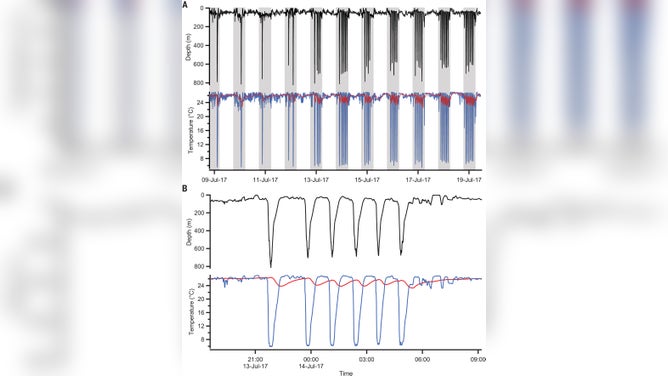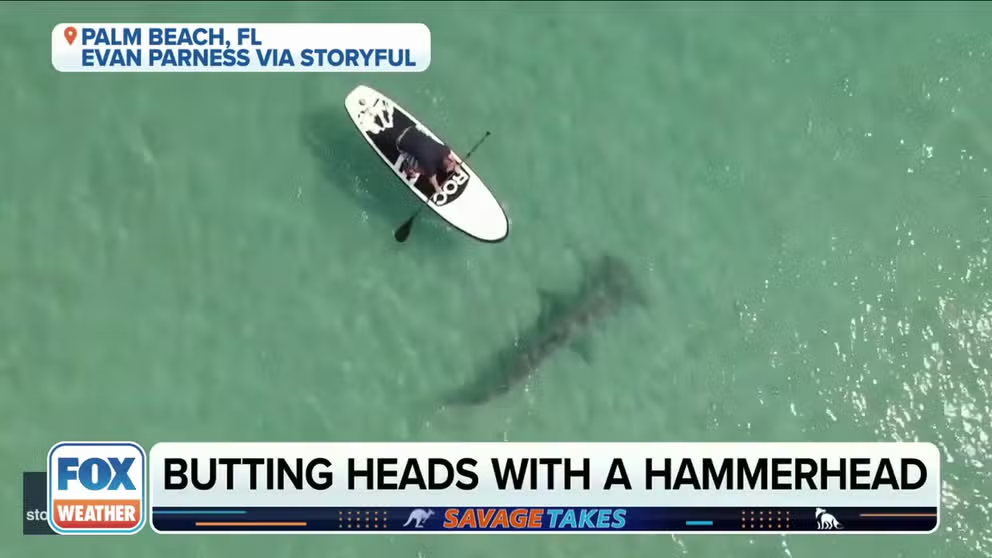This shark is the first fish found to ‘hold their breath'
A new study found that hammerhead sharks actually hold their breath when diving deep. Closing gills maintains the tropical fish's body temperature in chilly water.
Hammerhead shark chases stingrays close to Alabama beach
File: Video shows a hammerhead shark spotted chasing stingrays close to the shore of an Alabama beach.
As unbelievable as it sounds, scientists found a fish that holds its breath underwater. Just like their mammalian counterparts, hammerhead sharks stop breathing during deep dives.
They do have gills just like most fish, which allow the hammerheads to take in oxygen from the water and get rid of carbon dioxide. But they close off those gills, essentially holding their breath, hunting prey in the deep, a recent study published in the journal Nature found.
Breathing is not the issue for the tropical scalloped hammerhead, though, it is heat. Closing gill slits stops the cold water intake at depth, which holds in the animal's body temperature.
GREAT WHITE SHARK ENCOUNTERS ARE INCREASING DUE TO CLIMATE CHANGE

A scalloped hammerhead shark.
(Prisma Bildagentur/Universal Images Group / Getty Images)
Cold-blooded hunters
Muscles generate heat as every animal moves. Humans are warm-blooded, which means our bodies maintain their own temperature through their skin, sweat glands and blood vessels – the body’s heating and cooling system.
Hammerheads are cold-blooded ectotherms. Cold blood literally flows from the gills after heat exchange, according to the study.
"Ectotherms are any so-called cold-blooded animal—that is, any animal whose regulation of body temperature depends on external sources, such as sunlight or a heated rock surface," states Brittanica.com.
Tropical sharks hunt prey in frigid bottom waters
The hammerheads live in warm tropical oceans where temperatures hover around 78 degrees. But they frequently dive after prey, deeper than 2,600 feet, where water temperatures are around 40 degrees, the authors wrote.
PHOTOGRAPHER CAPTURES ‘JAWS-DROPPING’ PICTURES OF SHARKS

The sharks close the gills which are behind the eyes and ahead of the fins.
(Reinhard Dirscherl/ullstein bild / Getty Images)
"As fish move from warm to cold water, metabolic heat generated in muscle tissue is carried away by the blood and is rapidly lost to the environment at the gills," the authors wrote.
"Such deep diving is risky because body cooling can reduce visual acuity, cardiac function, and swimming muscle power, which could be detrimental for obligate ram ventilators—fish that rely on their forward movement to force water across their gills for respiration—such as scalloped hammerhead sharks," the study continued.
WHERE DO MOST SHARK ATTACKS HAPPEN IN THE US?
Hammerhead shark swims beneath paddleboarders in Florida
File: Drone footage shows a large hammerhead shark swimming under paddleboarders in Palm Beach, Florida.
After attaching instrument packets to adult hammerheads and taking video, the researchers found that the sharks close their gill slits to water. That action only allowed their muscle temperatures to drop a fraction of the water temperature around them. Their body temperature only dropped about 4 degrees, while the water temperature dropped almost 40 degrees.

(A) Eleven days of shark dives showing depth (top), ocean temperature (blue), and intramuscular (red) temperature profiles from scalloped hammerhead shark. All deep dives were conducted at night (gray shading). (B) Depth (top), ocean temperature (blue), and intramuscular (red) temperature profiles from scalloped hammerhead shark during six deep dives conducted in a single evening.
("Breath holding" as a thermoregulation strategy in the deep-diving scalloped hammerhead shark by Mark Royer et al. / FOX Weather)
The study says that other deep-feeding fish like tuna actually swim faster at depth to minimize contact with the cooler temperatures.

